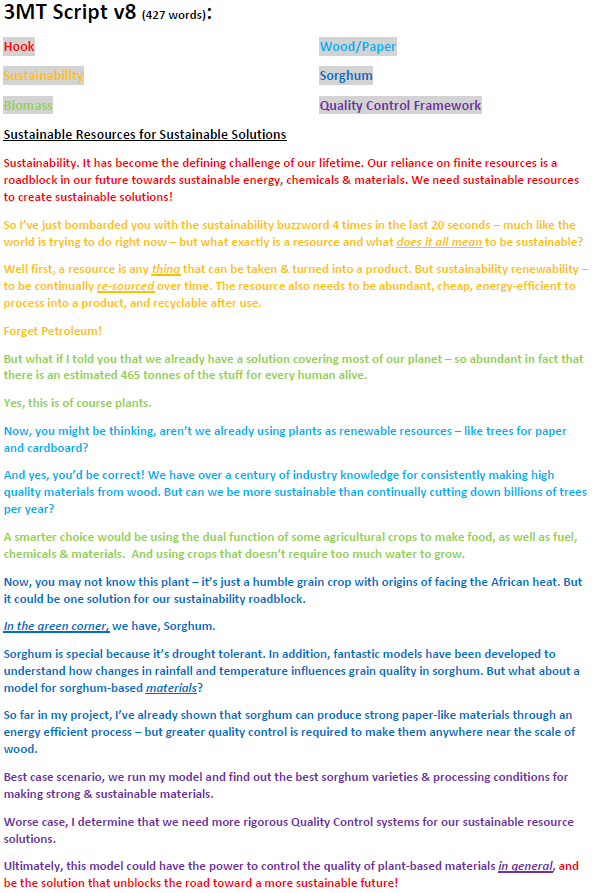Contenus de la page
Toggle3MT my thesis in 3 minutes
In order to prepare your 3MT speech (my thesis in 3 minutes), we will first scan the broad outlines of the form before looking at the content/substantive.
Tell a story
Write for your audience
Avoid jargon and academic language. Explain the concepts and people important to your research. You may know all about Professor Guerard's theories, but your audience does not. Highlight your search results and result wish. Imagine explaining your research to a close friend or classmate from another field. Convey your excitement and enthusiasm for your topic.
Tell a story
You may like to present your 3MT as a story, with a beginning, middle, and end. It's not easy to condense your research into three minutes, so you may find it easier to divide your presentation into smaller sections. Try toto write a introduction to attract the attention of the audience, then highlight your different points and finally write a summary to reaffirm the importance of your work.
Have a clear outcome in mind
Know what you want your audience to take away from your presentation. Try to let the audience understand what you do, why it's important and what you hope to achieve.
Revise
Prove your 3MT presentation by reading it aloud, in front of yourself and in front of a small audience who will comment on your words.
Simple, brief and effective
Use short sentences with a single message. Do not hesitate to pace your speech with coordinating conjunctions or adverbs (But, Therefore, However, etc.).
Avoid using jargon that is too specific and explain the key principles in pictorial and simple terms.
Here is the structure of your speech:
- Introduction.
- Capture the audience's attention from the start with a hook (e.g. ask a question, tell a
history, give a contemporary example). - Briefly introduce yourself after your hook.
- Capture the audience's attention from the start with a hook (e.g. ask a question, tell a
- Body (your research).
- Provide context/background for your research.
- Keep messages simple.
- Articulate the importance of your research to society.
- Use examples that the audience will relate to.
- Conclusion.
- Return to your introduction to close your presentation.
- End on a good note.
- Thanks to the public!
The hook
Every great 3MT presentation begins with an attention-grabbing introduction, also known as the “hook.” This is an essential element of storytelling and is undoubtedly one of the most important elements of the 3MT script.
A smart way to hook the audience during a 3MT presentation is to start by asking a question, which creates a feeling of open dialogue with the listener. For example, these 3MT finalists began their presentation by asking:

Finally, many fantastic 3MT presentations also begin with a hook that surprises the reader by making an unusual, interesting, or thought-provoking statement. This can be done in several ways, for example using:
- Oxymoron: A figure of speech that combines two contradictory words (i.e. “deafening silence” and “old news”).
- Paradox: A contradictory statement that may actually be true (i.e. “less is more”).
- Irony: Using words to express the opposite of their literal meaning (i.e. telling a rude customer to "have a nice day").

The success of this technique comes from its element of surprise, which keeps the listener intrigued and curious. Basically, the more shocking or unexpected the hook, the better.
However, that being said, there is definitely no “right” or “wrong” way to start your 3MT, and that is the beauty of creativity. But in case you're stuck for ideas, here are some starter phrases to inspire you to create a compelling hook for your 3MT script:
- “What if I told you”
- “Think about”
- “How many of you”
- “Imagine that”
- “Take a look at”
- “Did you know”
Tell a story
usually at the beginning of a story there is exposition. These are facts that help set the scene and ensure that the speaker and audience are all on the same page (pun intended). 😉 These facts can be linked using the word AND. For example:
“Cancer is fatal and traditional chemotherapy is a treatment option. »
All the statements we associate with "and" are usually things that everyone would agree with, so you can check the quality of your "and" section by making sure you agree with all the facts that you connect.
Okay, so we've set the scene. But it's not really a story yet, is it? The real story only begins when there is a source of tension or conflict, and the easiest word for that to happen is the word BUT:
“Cancer is deadly and traditional chemotherapy is a treatment option, but it has many side effects. »
You see it’s the “but” that makes things interesting. This is what makes the audience want to know more and ask, “Well, what happens next?” »
It doesn’t have to be the word “but” either – there are plenty of words that do essentially the same thing, like however, although, except and unfortunately, to name a few… (The thesaurus might be your best friend here). What these words have in common is that they create this critical feeling of tension.
Then comes the result, and that's where the SO comes in.
“Cancer is fatal and chemotherapy is a treatment option, but it has many side effects. Therefore, in our research, we load these drugs into tiny carriers called nanoparticles, which can help reduce their side effects.
“Therefore” is the word that brings it all together. This marks the beginning of a journey of discovery, which ultimately leads to resolution.
You can see how, by simply including these three key words: and, but and so, we have generated the foundation of a good story. Your 3MT script will obviously need to be more than two sentences long, but the ABT model provides a useful scaffold from which you can build to ensure your story is compelling. If you want to learn more about the ABT model and how it can be used, be sure to read Connection.
To help you shape your story using the ABT model, here are some questions which you can attempt to answer at the beginning, middle and end of your 3MT script:
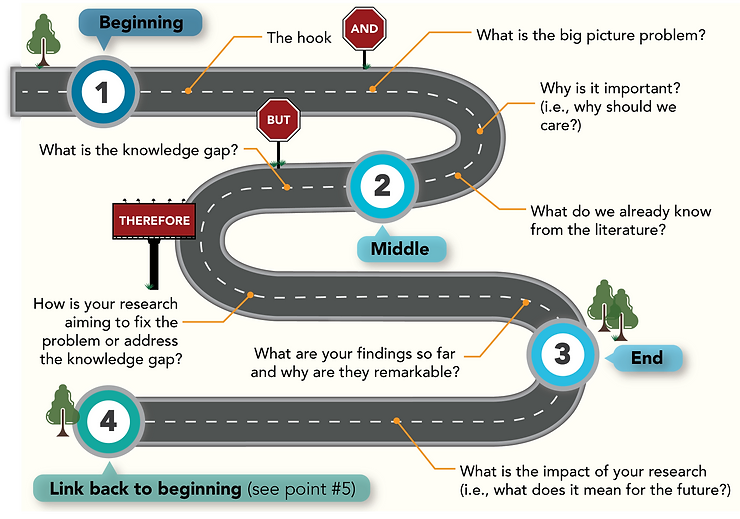
Do not hesitate to illustrate your words in order to avoid overly technical jargon.
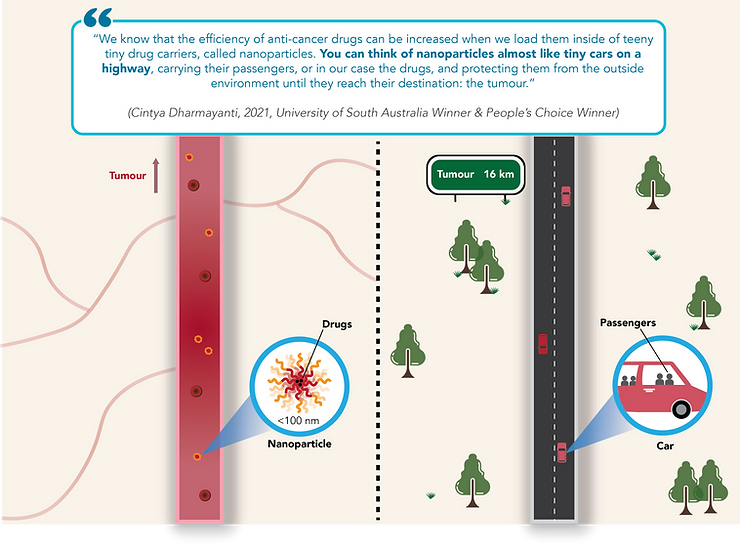
The final
It's time to add the finishing touches. We can all agree that a strong finish makes the presentation more memorable. A very common trend among winning 3MT presentations is the way they end: by bringing their story full circle. As the name suggests, this essentially means that the presenter refers to the beginning of the story, especially if a particular character, scenario or analogy is used.

One and only one slide
For your 3MT, you only have the right to display one slide, its content and message and therefore very important! Be careful not to draw the public's attention to the slide, you are the priority center of interest. Your slide does not transmit a new message, but on the contrary it carries your opening message.
Use images that are easy to understand and convey your story. Use a minimum of text, and especially no sentences! Don’t forget to add your name in a lower corner…
Avoid scientific figures and diagrams
Unlike a conference presentation, your 3MT slide should simply be used to enhance and complement your script, rather than being used to display complex data and graphs. In fact, I would suggest avoiding the use of complex data charts and tables at all, as they end up distracting from what you are saying.
If you choose to present important data or statistics in your 3MT slide, consider replacing the charts with simple infographics, like pie charts or diagrams:
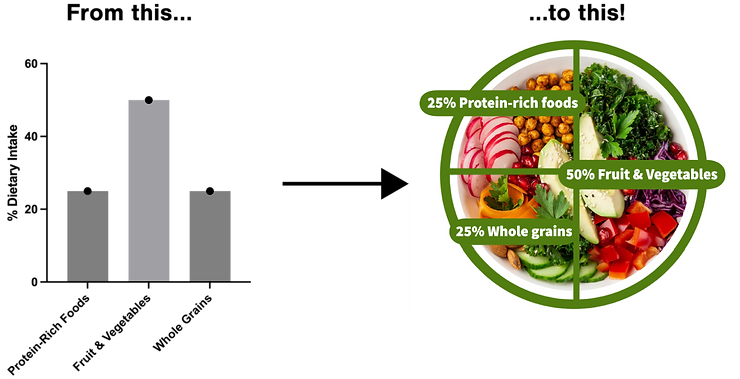
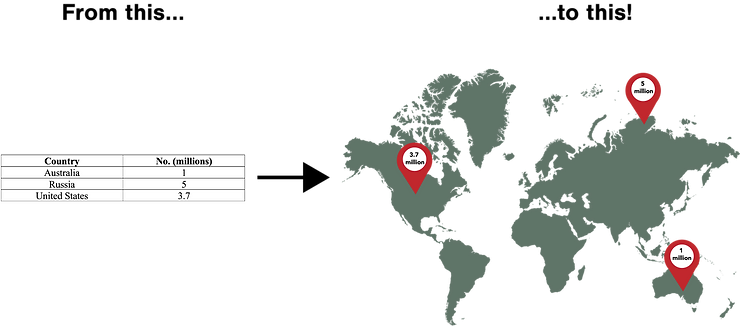
In fact, you'll find that most successful 3MT users show little or no data in their slides and intentionally keep them very conceptual.
Stay conceptual
This keeps the presentation focused on the speaker, with the slide simply acting as a visual aid to complete the story. And when it comes to a public speaking competition, I'd say it's pretty important.
In our humble opinion, some of the most effective and memorable 3MT slides are those that feature an image or diagram that conveys a unique underlying concept or idea.

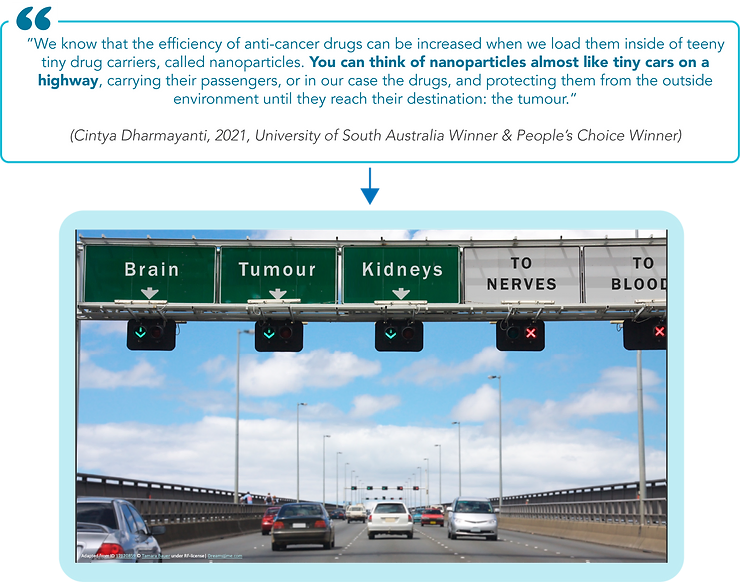
Your first step is to write your 3MT script. Then, once you have your script prepared, use it as a tool to help you brainstorm ideas for your slide. Note if you used analogies, introduced characters, or covered certain concepts, then, based on that information, find or create a visual to match!
Image: Opt for a strong message that is understandable at a glance
In the same way that the “hook” in your 3MT script helps grab the audience’s attention, the slide is another important tool for capturing their attention and keeping them engaged. But to do that, it needs to be catchy and interesting.
Most winning 3MTs contain slides that generally fall into one of two categories: images or diagrams.
These are usually photographs or illustrations that complement the storyline in some way – containing reference to the concept, analogy or characters introduced in the storyline.
For example, let's say you introduced a fictional character into your 3MT script. By visually showing this character in your slide, it helps the audience connect with them and tap into their sense of empathy.
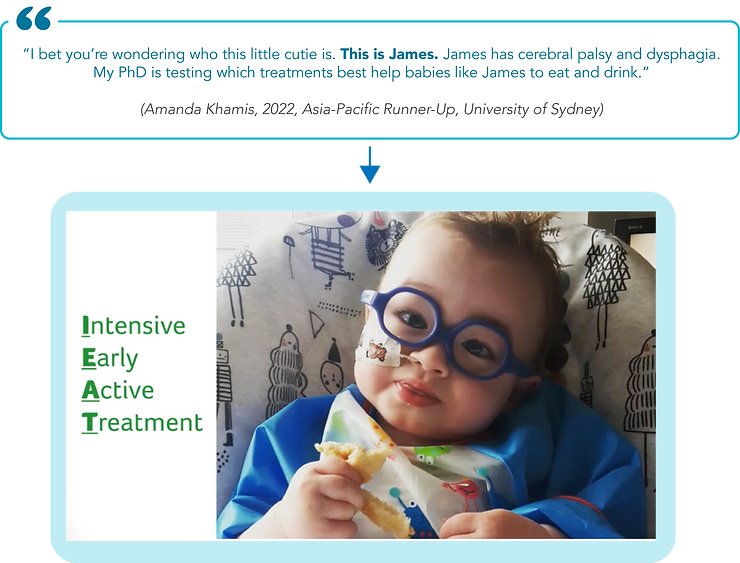
However, images do not need to depict people to be effective: they can also be more conceptual.
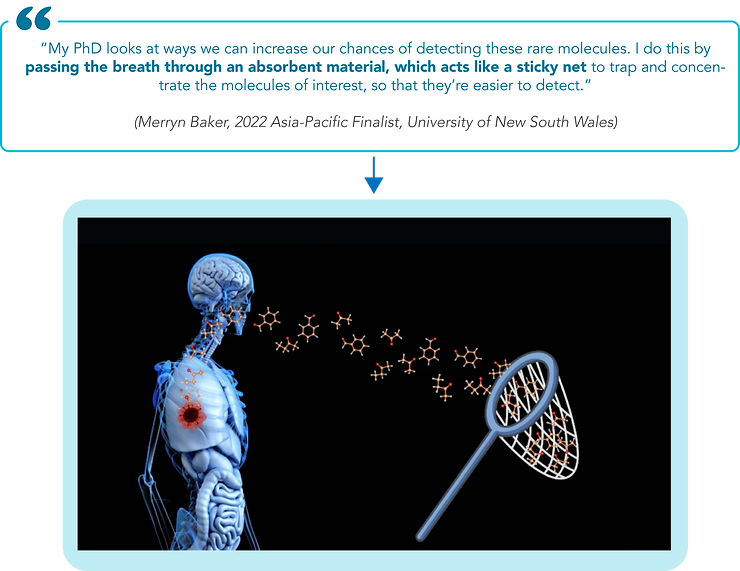
Not only is this image a great reference to the internet analogy used, but we (as an audience) are able to get a basic idea of the search concept based on the slide alone, which really helps it to remain engraved in our memory!
Diagram: be understandable and direct
Besides images, schematic diagrams can be another great way to conceptualize and visualize your research. However, to be effective as 3MT slides, diagrams must be simple and easy to understand.
Ideally, they should be short and the results immediately recognizable. Avoid using complex diagrams that you have directly copied and pasted from a paper, as understanding them usually takes much more time and concentration.
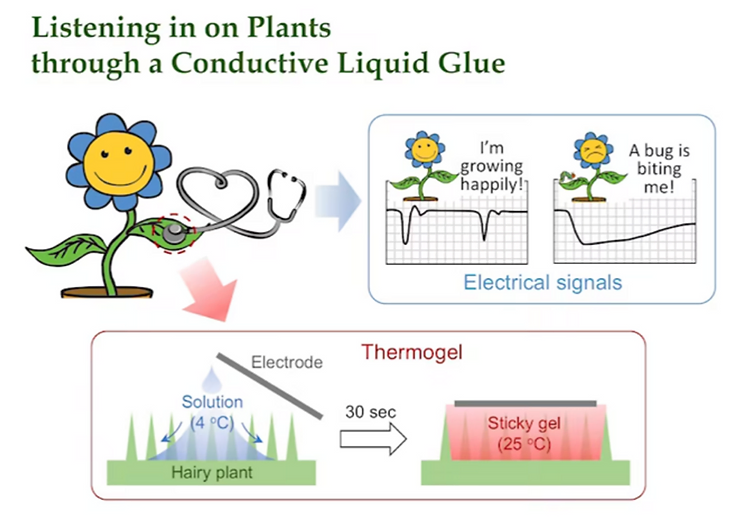
In this example, it is easy to understand the research topic, what is being measured and what the desired results are, thanks to the clear illustrations and moving flower drawings.
Use negative spaces
But what is negative space? In simple terms, it is the empty space around and between objects.
You might be tempted to fill every visible inch of your slide with images, diagrams, or just something to make up for the very little time you have to present your 3MT.

However, you would be doing yourself a disservice if you did so, because a little negative space can go a long way in designing a great 3MT slide.
Checklist for finalizing the speech
• Have you introduced yourself?
• Have you been explicit about your take-home message?
• Did you speak in short sentences so that the audience could easily follow the ideas?
• Have you used vocabulary that your audience can understand, i.e. limited use of domain-specific jargon?
• Did you use speech markers to guide the audience through the speech?
• Have you supported your statement with examples and/or evidence?
• Did you face the audience?
• Did you scan the audience to make eye contact?
• Did you speak fluently without making hesitant sounds?
• Did you speak at a pace that allowed the audience to digest the ideas? (aim for 150 words per minute)
• Have you exhibited nervous behaviors?
• Did you use visual elements to support your points?
• Did you thank the audience for listening/for their attention?
• Did you seem prepared?
Some examples
Michelle Duong, Food Science and Technology: “Franken-phage to save the day”
Narrator: Cornell University 2019 Three Minute Thesis Finalist. Michelle Duong, food science and technology: “Franken-phage to save the day”: Franken-phage
Every year, one in ten people around the world become ill simply from eating or drinking. One of the main reasons is contaminated water. 25 percent of the world's population does not have access to drinking water. To solve this problem, my thesis focuses on the development of biotechnology that allows end users to check if their water is contaminated with pathogenic bacteria. My goal is to develop an inexpensive, qualitative, fast-acting diagnostic tool to detect bacteria and low-resource settings. For example, if you are traveling abroad and there is no water, what do you do? Or if you are serving in the military in a remote area or even in the United States if you work in food production plants, there is no quick way to detect and screen for bacterial contamination. There method Current reference to detect bacteria takes three days, requires clean samples, complex instruments and trained personnel. My approach uses phages, short for bacteriophages, to detect bacteria. Phages are a type of beneficial virus that only infect bacteria and are harmless to humans. Phages are also inexpensive and easy to produce and, importantly, only infect live, active bacteria. In addition, phages, among others, infect a bacterium with its own, with the fibers of its tail. What I did was assemble a library of efficient tail fibers to design my new phage called Franken-phage. The Franken phage has mixed tail fibers, so one Franken phage can infect many species of bacteria and not just one. Additionally, upon detection of harmful bacteria, my Franken-phage causes a color change, alerting end users to the presence of harmful bacteria in their water. So imagine if I had a cocktail of these Franken phages adapted to detect different bacteria, the possibilities are endless. My next step is to take this proof of concept and bring it to market. Next month we will conduct our first field test in Kenya to achieve the UNICEF Water Safety goal. So when you're traveling overseas in two years or serving in the military, you'll count on this technology to keep you safe in just minutes. Remember, this is where you first heard about the Franken-phage. THANKS.
Rewrite your text until you obtain the greatest fluidity:

And the latest version:
